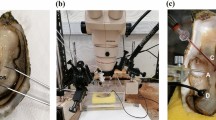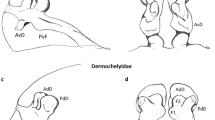Abstract
The potential for intraspecific chemical communication in the gilthead seabream (a marine perciform) was investigated by assessing the olfactory sensitivity to conspecific body-fluids (water occupied by conspecifics, intestinal fluid, urine, semen, egg fluid) by multiunit electrophysiological recording from the olfactory nerve. The olfactory system was responsive to water previously occupied by conspecifics, and the active compound(s) could be extracted by solid-phase extraction. The olfactory system was extremely sensitive to body fluids of sexually mature conspecifics: thresholds of detection were 1:107.4 (intestinal fluid), 1:106.1 (gametes), and 1:104.2 (urine). The olfactory system was also sensitive to amino acids with thresholds of detection from 10−8.1 M (l-leucine) to 10−6.1 M (l-phenylalanine). However, a range of other known fish odorants (steroids, bile acids, and prostaglandins) failed to evoke significant responses. Given the high olfactory sensitivity to intestinal fluid and the low urine release rates of marine compared with freshwater fish, we suggest that chemical communication is likely to be mediated via compounds present in the intestinal fluid rather than urine. Furthermore, the types of chemicals involved are likely to be different from those of freshwater fish. Their exact chemical identity and biological roles remain to be established.
Similar content being viewed by others
References
Appelt, C. W. and Sorensen, P. W. 1999. Freshwater fish release urinary pheromones in a pulsatile manner, pp. 247–256, in R. E. Johnston, D. Müller-Schwarze, and P. W. Sorensen (Eds.). Advances in Chemical Signals in Vertebrates. Kluwer Academic/Plenum Publishers, New York.
Brown, J. A., Olivier, J. A., Henderson, I. W., and Jackson, B. A. 1980. Angiotensin and single nephron function in the trout Salmo gaidneri. Am. J. Physiol. 239:R509–R514.
Caprio, J. and Byrd, R. P., Jr. 1984. Electrophysiological evidence for acidic, basic, and neutral amino acid olfactory receptor sites in the catfish. J. Gen. Physiol. 84:403–422.
Claiborne, J. M., Walton, J. S., and Compton-Mccullough, D. 1994. Acid–base regulation, branchial transfers and renal output in a marine teleost fish (the long-horned sculpin Myoxocephalus octodecimspinosus) during exposure to low salinities. J. Exp. Biol. 193:79–95.
Dillon, R. J., Vennard, C. T., and Charnley, A. K. 2000. Exploitation of gut bacteria in the locust. Nature 403:851.
Doving, K. B., Selset, R., and Thommesen, G. 1980. Olfactory sensitivity to bile acids in salmonid fishes. Acta Physiol. Scand. 108:123–131.
Fishelson, L. 1995. Comparative morphology and cytology of the olfactory organs in moray eels with remarks on their foraging behavior. Anat. Rec. 243:403–412.
Fletcher, C. R. 1990. Urine production and urination in the plaice Pleuronectes platessa. Comp. Biochem. Physiol. 96A:123–129.
Frade, P., Hubbard, P. C., Barata, E. N., and Canário, A. V. M. 2002. Olfactory sensitivity of Oreochromis mossambicus to conspecific odours. J. Fish Biol. 60:1239–1254.
Friedrich, R. W. and Korsching, S. I. 1997. Combinatorial and chemotopic odorant coding in the zebrafish olfactory bulb visualized by optical imaging. Neuron 18:737–752.
Goh, Y. and Tamura, T. 1980. Olfactory and gustatory responses to amino-acids in two marine teleosts—red-sea bream and mullet. Comp. Biochem. Physiol. 66C:217–224.
Goh, Y., Tamura, T., and Kobayashi, H. 1979. Olfactory responses to amino-acids in marine teleosts. Comp. Biochem. Physiol. 62A:863–868.
Happe, A. and Zohar, Y. 1988. Self-fertilization in the protandrous hermaphrodite Sparus aurata. Development of the technology, pp. 177–180, in Y. Zohar and B. Breton (Eds.). Reproduction in Fish—Basic and Applied Aspects in Endocrinology and Genetics. INRA Press, Paris, France.
Hara, T. J. 1994. Olfaction and gustation in fish—an overview. Acta Physiol. Scand. 152:207–217.
Hubbard, P. C., Barata, E. N., and Canário, A. V. M. 2000. Olfactory sensitivity to changes in environmental [Ca2+] in the marine teleost Sparus aurata. J. Exp. Biol. 203:3821–3829.
Ishida, Y. and Kobayashi, H. 1992. Stimulatory effectiveness of amino-acids on the olfactory response in an algivorous marine teleost, the rabbitfish Siganus fuscescens Houttuyn. J. Fish Biol. 41:737–748.
Kitamura, S. and Ogata, H. 1989. Olfactory responses of male amago salmon, Oncorhynchus rhodurus, to the urogenital fluid of ovulated female. Comp. Biochem. Physiol. 94A:713–716.
Knutsen, J. A. 1992. Feeding behavior of North Sea turbot (Scopthalmus maximus) and Dover sole (Solea solea) larvae elicited by chemical stimuli. Mar. Biol. 113:543–548.
Kobayashi, H. and Goh. Y. 1985. Comparision of the olfactory responses to amino-acids obtained from receptor and bulbar levels in a marine teleost. Exp. Biol. 44:199–210.
Li, W., Scott, A. P., Siefkes, M. J., Yan, H., Liu, Q., Yun, S.-S., and Gage, D. A. 2002. Bile acid secreted by male sea lamprey that acts as a sex pheromone. Science 296:138–141.
Li, W. and Sorensen, P. W. 1997. Highly independent receptor sites for naturally occurring bile acids in the sea lamprey, Petromyzon marinus. J. Comp. Physiol. A 180:429–438.
Li, W., Sorensen, P. W., and Gallaher, D. D. 1995. The olfactory system of migratory adult sea lamprey (Petromyzon marinus) is specifically and acutely sensitive to unique bile acids released by conspecific larvae. J. Gen. Physiol. 105:569–587.
Mackie, A. M., Adron, J. W., and Grant, P. T. 1980. Chemical nature of feeding stimulants for the juvenile Dover sole, Solea solea (L.). J. Fish Biol. 16:701–708.
Mana, R. R. and Kawamura, G. 2002. A comparative study on morphological differences in the olfactory system of red sea bream (Pagrus major) and black sea bream (Acanthopagrus schlegeli) from wild and cultured stocks. Aquaculture 209:285–306.
McDonald, M. D., Wood, C. M., Wang, Y., and Walsh, P. J. 2000. Differential branchial and renal handling of urea, acetamide and thiourea in the gulf toadfish Opsanus beta: Evidence for two transporters. J. Exp. Biol. 203:1027–1037.
Meiri, I., Gothilf, Y., Zohar, Y., and Elizur, A. 2002. Physiological changes in the spawning gilthead seabream, Sparus aurata, succeeding the removal of males. J. Exp. Zool. 292:555–564.
Michel, W. C. and Lubomudrov, L. M. 1995. Specificity and sensitivity of the olfactory organ of the zebrafish, Danio rerio. J. Comp. Physiol. A 177:191–199.
Scott, A. P., Liley, N. R., and Vermierson, E. L. M. 1994. Urine of reproductively mature female trout, Oncorhnychus mykiss (Walbaum), contains a priming pheromone which enhances plasma levels of sex steroids and gonadotrophin II in males. J. Fish Biol. 44:131–147.
Smith, R. J. F. 1992. Alarm signals in fishes. Rev. Fish Biol. Fisher. 2:33–63.
Sorensen, P. W. and Caprio, J. 1998. Chemoreception, pp. 375–405, in D. H. Evans (ed.). The Physiology of Fishes, 2nd Edition. CRC Press, Boca Raton, Florida.
Sorensen, P. W., Christensen, T. A., and Stacey, N. E. 1998. Discrimination of pheromonal cues in fish: Emerging parallels with insects. Curr. Opin. Neurobiol. 8:458–467.
Sorensen, P. W., Hara, T. J., Stacey, N. E., and Goetz, F. W. M. 1988. F prostaglandins function as potent olfactory stimulants that comprise the postovulatory female sex pheromone in goldfish. Biol. Reprod. 39:1039–1050.
Stacey, N. E., Sorensen, P. W., Van Der Kraak, G. J., and Dulka, J. G. 1989. Direct evidence that 17α,20β-dihydroxy-4–pregnen-3–one functions as a primer pheromone: Preovulatory release is closely associated with male endocrine responses. Gen. Comp. Endocrinol. 75:62–70.
Waring, C. P., Moore, A., and Scott, A. P. 1996. Milt and endocrine responses of mature male Atlantic salmon (Salmo salar L.) parr to water-borne testosterone, 17,20β-dihydroxy-4–pregnen-3–one 20–sulfate, and the urines from adult female and male salmon. Gen. Comp. Endocrinol. 103:142–149.
Wilson, R. W., Gilmour, K. M., Henry, R. P., and Wood, C. M. 1996. Intestinal base excretion in the seawater-adapted rainbow trout: A role in acid–base balance? J. Exp. Biol. 199:2331–2343.
Zar, J. H. 1984. Biostatistical Analysis, 2nd edn. Prentice-Hall, London.
Zhang, C., Brown, S. B., and Hara, T. J. 2001. Biochemical and physiological evidence that bile acids produced and released by lake char (Salvelinus namaycush) function as chemical signals. J. Comp. Physiol. B 171:61–171.
Zohar, Y., Abraham, M., and Gordin, H. 1978. The gonadal cycle of the captivity-reared hermaphroditic teleost Sparus aurata (L.) during the first two years of life. Ann. Biol. Anim. Biochim. Biophys. 18:877–882.
Zohar, Y., Billard, R., and Weil, C. 1984. La reproduction de la daurade (Sparus aurata) et du bar (Dicentrarchus labrax): connaissance du cycle sexual et contrôle de la gamétogenèse et de la ponte, pp. 3–24, in G. Barnabé and R. Billard (Eds.). L'Aquaculture du Bar et des Sparidés. INRA Publishers, Paris, France.
Author information
Authors and Affiliations
Corresponding author
Rights and permissions
About this article
Cite this article
Hubbard, P.C., Barata, E.N. & Canário, A.V.M. Olfactory Sensitivity of the Gilthead Seabream (Sparus auratus L) to Conspecific Body Fluids. J Chem Ecol 29, 2481–2498 (2003). https://doi.org/10.1023/A:1026357917887
Issue Date:
DOI: https://doi.org/10.1023/A:1026357917887




